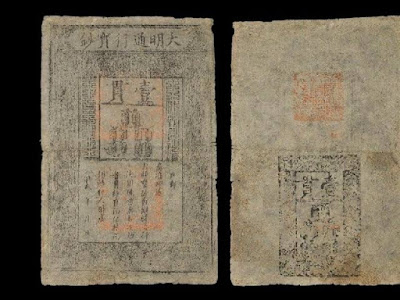Do you recall what the first banknote in history looked like? Many people are unaware that banknotes date back to 997 AD. Money has changed significantly over time, evolving from stones and metals to the ultimate form we see today: banknotes.
Do you know what the first banknote in history was? What is the background?
Come on, read the entire review in the Financialworld99 explanation below!
The World's First Banknote
According to information taken from the Bank Indonesia official website, the world's first banknote, known as the "Jiaozi," was found in mainland China in the year 997 AD. According to Guinness World Records, the "Flying Money" utilized by affluent merchants and government officials during China's Tang Dynasty is where these banknotes got their start (618–907).
This floating currency is comparable to a modern bank money order that enables consumers to deposit cash with local officials and receive a written receipt (receipt). You can afterwards trade in this receipt for the equivalent amount somewhere else. Additionally, Flying Money is not exchangeable between people and is not accessible to the public.
Over time, during the Song Dynasty in China, the first paper currency that was comparable to modern banknotes initially appeared (960-1279 AD). The first legal tender was a promissory note called the "Jiaozi."
During the reign of Emperor Zhenzong, a group of merchants in Sichuan produced these "Jiaozi" banknotes (997-1022 AD). Jiaozi can be utilized by the public and can even be exchanged for coins that have previously appeared, in contrast to Flying Money, which cannot be exchanged between individuals.
Read also: History Of Money: From Barter To Digital Money
Huizi was changed Jiaozi
Jiaozi was at one point a pretty well-known currency, but after a few decades it started to have issues with inflation. New paper money called "Huizi," which was printed by the government in authorized printing facilities, was introduced to replace the Jiaozi.
Huizi is constructed of paper that is A4 size. A pastoral scene that was printed from a copper plate makes up this currency. As an additional mark of legitimacy, Huizi is embellished with handwritten denominations that have a red ink stamp. A warning inscription for anyone who forges this money is included with Huizi in the print.
These banknotes' use is still undergoing dramatic changes. Finally, the value of banknotes began to decline in China, which had just gone through a terrible financial crisis. As a result, after more than 500 years of use, China stopped using banknotes in 1455.
After the 17th century, banknotes were only once again in circulation, and this time in Continental Europe. However, despite being widely used at the time, archaeologists have not discovered a single example of a Huizi banknote that has survived to the present day. Only one sample of a printing plate used to create banknotes, which is assumed to have been used in 1023, was discovered.

